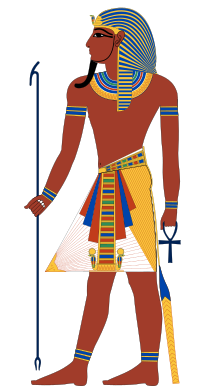Imperial cult
This article needs additional citations for verification. (June 2021) |

An imperial cult is a form of
Historical imperial cults
Ancient Egypt
The Ancient Egyptian pharaohs were, throughout ancient Egyptian history, believed to be incarnations of the deity Horus; thereby derived by being the son of Osiris, the afterlife deity, and Isis, goddess of marriage.
The Ptolemaic dynasty based its own legitimacy in the eyes of its Greek subjects on their association with, and incorporation into, the imperial cult of Alexander the Great.
Imperial China
In
Ancient Rome
Even before the rise of the Caesars, there are traces of a "regal spirituality" in Roman society. In earliest Roman times the king was a spiritual and
King Numitor corresponds to the regal-sacred principle in early Roman history. Romulus, the legendary founder of Rome, was heroized into Quirinus, the "undefeated god", with whom the later Caesars identified and of whom they considered themselves incarnations.
In Plutarch's Phyrro, 19.5, the Greek ambassador declared amid the Roman Senate he felt instead like being in the midst of "a whole assembly of Kings".
As the Roman Empire developed, the Imperial cult gradually developed more formally and constituted the worship of the Roman emperor as a god. This practice began at the start of the Empire under Augustus, and became a prominent element of Roman religion.
The cult spread over the whole Empire within a few decades, more strongly in the east than in the west. Emperor Diocletian further reinforced it when he demanded the proskynesis and adopted the adjective sacrum for all things pertaining to the imperial person.
The
Ancient and Imperial Japan

In
- Western World), until the end of World War II.
- Ningen-sengen – the declaration with which the Emperor Shōwa, on New Year's Day 1946, (formally) declined claims of divinity, keeping with traditional family values as expressed in the Shinto religion.
In the 16th, 19th, and 20th centuries, Japanese nationalist philosophers paid special attention to the emperor and believed devotion to him and other political causes that furthered the Japanese state was "the greatest virtue".[1] However, in the 14th century, most religious figures and philosophers in Japan thought that excessive veneration of the state and the emperor would consign one to hell.[1]
Ancient Southeast Asia
In the
Timurid and Mughal Empire

The Emperors of the Timurid and Mughal Dynasty were regarded as intermediaries of their subordinaries and God by virtue of the blessings of the Hazrat Ishaans, who were the spiritual guides of the Timurid and Mughal Emperors. The Emperors believed in the Hazrat Ishaans to be the rightful spiritual successors of Muhammad and by this virtue to be the ultimate intermediaries between God and mankind in every time (Qutb). They thus used the title Zwillu-Nabi’llah (ظِلُّ النبی ٱلله) or "Sayeh Nabi-e- Khuda" in Persian which means "Shadow of God´s Prophet" in English to denote their representation of God on Earth.[4][5][6]
Examples of divine kings in history

Some examples of historic leaders who are often considered divine kings are:
- Africa
- Pharaohs of Ancient Egypt
- Shilluk Kingdom was ruled by a divine monarchy
- Ghanas (Kings) of the Empire of Ghana
- Asia
- God Worshipping Society leader Hong Xiuquan, leader of the Taiping Rebellion, claimed to be Christ's younger brother, and attempted to establish rule as a divine king
- Korean Gung-ye, King of Taebong
- The Japanese emperors up to the end of World War II
- Javanese Kings during Hindu-Buddhist era (4th–15th centuries AD) such as Kediri, Singhasari and Majapahitempire
- Kings of Khmer Empire, Cambodia
- Srivijaya emperors
- Americas
- Kings of the Maya city-states of the Classical period[7]
- Sapa Incas in pre-Hispanic South America; considered descendants of the sun god Inti.[8]
- Oceania
- Akua Aliʻiof the Hawaiian Islands before 1839
- Europe
- Many Roman emperors were declared gods by the Roman Senate (generally after their death; see Roman imperial cult).
See also
- American civil religion
- Apotheosis
- Atenism
- Buddhist kingship
- Cult of personality
- Divine right of kings
- Emperor of Japan
- Euhemerism
- God complex
- King-Emperor
- Mandate of Heaven
- Nicolae Ceausescu's cult of personality
- North Korean cult of personality
Notes
- ^ ISBN 978-1838862145.
- ISBN 8189233262. Archived from the originalon 9 December 2012. Retrieved 14 September 2012.
- ^ Drs. R. Soekmono (1988) [1973]. Pengantar Sejarah Kebudayaan Indonesia 2, 2nd ed (5th reprint ed.). Yogyakarta: Penerbit Kanisius. p. 83.
- JSTOR 44147955– via JSTOR.
- ^ "Power & Desire".
- ^ "Main Elements and Structure of the Mughal Administration". 29 November 2014.
- ^ Sharer and Traxler 2006, p. 183.
- ^ Wilfred Byford-Jones, Four Faces of Peru, Roy Publishers, 1967, pp. 17, 50.
References
- OCLC 57577446.
Further reading
- Ameresekere, H. E. (July 1931). "The Kataragama God: Shrines and Legends". Ceylon Literary Register. Kataragama.org. pp. 289–292. Archived from the original on January 12, 2016. Retrieved 20 April 2016.
- Baptist, Maria (Spring 1997). "The Rastafari". Buried Cities and Lost Tribes. Mesa Community College. Archived from the original on June 5, 2008. Retrieved 20 April 2016.
- Effland, Richard (Spring 1997). "Definition of Divine kingship". Buried Cities and Lost Tribes. Mesa Community College. Archived from the original on June 5, 2008. Retrieved 20 April 2016.
- Effland, Richard; Lerner, Shereen (Spring 1997). "The World of God Kings". Buried Cities and Lost Tribes. Mesa Community College. Archived from the original on July 5, 2008. Retrieved 20 April 2016.
- Marglin, F. A. (1989). Wives of the God-King: The Rituals of the Devadasis of Puri. New Delhi: Oxford University Press. ISBN 0195617312.
